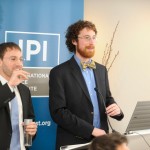On November 9, TechChange President Nick Martin and the TechChange team were invited to participate in a roundtable discussion co-hosted by the International Peace Institute and the UNDP’s Bureau for Crisis Prevention and Recovery on crowdsourcing for conflict prevention.
The discussion covered the policy challenges associated with crowdsourcing at a national level, as well as discussions about tools and human factors. The UNDP’s Ozonnia Ojielo expertly explained the Amani 108 process in Kenya, Nick Martin and Google’s Beth Liebert spoke about communication and mapping tools involved in the process of crowdsourcing, and William Tsuma of the Global Partnership for the Prevention of Armed Conflict talked about the human side of crowdsourcing, including the risks people face when participating.
Ozonnia Ojielo gave the audience an in-depth analysis of why the Amani 108 program, co-managed by the UNDP and Kenyan Government, was so effective for preventing significant outbreaks of violence during the referendum vote in 2010. He explained the level of buy-in across all levels of society, and that there was both information gathering capacity and the ability to respond when needed.
Moving off this case study, Nick Martin, with the help of Jordan Hosmer-Henner, talked about the social tools for crowdsourcing, including FrontlineSMS, Twitter, and Freedom Fone. Since these systems can provide a data analyst with geographic information, the TechChange team had put together a crowdmap and provided the audience with information to text into a FrontlineSMS platform. Jordan then demonstrated how the texts are received in the crowdmap, and how to map them. This was a nice interactive touch, and allowed participants who may not have seen mapping platforms to interact briefly with the software from their seats.
Beth Liebert expanded on Nick and Jordan’s presentation, giving a detailed explanation of Google’s mapping products. She demonstrated how the maps incorporated layering technology that could be easily used by non-technical practitioners, demonstrating the platform with a map that was designed during the London riots to provide information on police activity, safe spaces and different types of events. This information is all crowdsourced using the tools that Nick and Jordan discussed, and Beth provided a superb explanation of the depth and capacity Google mapping products have for bringing data to life.
William Tsuma brought the conversation back to the operational side, speaking about the challenges of organizing crowdsourcing operations in environments where security was a problem and the issues surrounding data sharing with governments and security agencies. His suggestions demonstrated practical examples of how to work around these challenges, as well as methods that professionals could employ while working on crowdsourcing at the community level.
The discussion covered the range of issues at the policy level, covered tools and technical needs for crowdsourcing, and brought the conversation back to the core issue, that we are trying to improve the lives of people affected by conflict and instability. Roundtables like these, hosted by organizations doing good work in the field and supporting critical research on conflict prevention, provide a space to discuss the intersection of tools, policy and human challenges of crowdsourcing while giving a variety of experts the opportunity to ask questions and share their insights.

